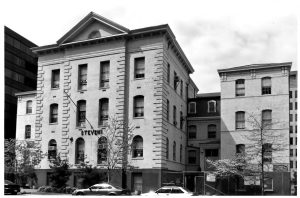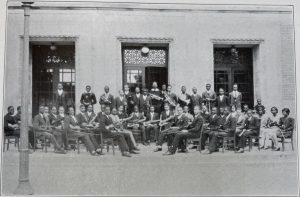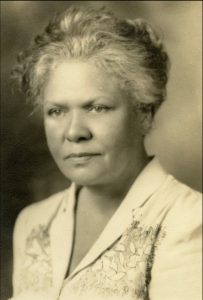Alumni in the Schools: Teachers
Teaching was a natural occupation choice for many of Washington Conservatory graduates, not least because segregation prevented other career opportunities from being available. Education was seen as a respectable profession that was in accord with racial uplift ideology.1 Social refinement and education also shaped the Black elite as a social class.2 Many Black women became teachers around the turn of the 20th century, and music teachers specifically had significant impacts on their communities.3 Such societal influences help explain the fact that twenty-six of the thirty graduates at the center of this project, an overwhelming majority, went on to teach at some point in their career. They taught in almost every kind of educational institution, from primary schools through higher education.
The majority became music teachers; a smaller number of graduates taught outside of music, but undoubtedly used their musical training to strengthen the fabric of Black communities across the country. Each of these teachers’ stories are featured in the map below, which shows where Washington Conservatory graduates taught.
Click here for a narrative description of the map below. The map title below links to the full web map. You can also access the information presented in this map by downloading our data in spreadsheet form. Hover over the map and zoom in to view data in Washington, DC.
Institutions at which Washington Conservatory Graduates Taught, Color-Coded by Institution Type
Most graduates of the Washington Conservatory became teachers. This map visualizes educational institutions Washington Conservatory graduates taught at. Zoom in to Washington, DC to view more detailed data.
The map aims to make visible what Doris McGinty has called the “anonymous infrastructures” of teachers that came from the Washington Conservatory.4 Twenty-one of the twenty-six teachers can be seen on the map; we could not determine the institutions at which the other five taught, although their occupations were described as “teacher” in census and city directory records. Each point is color-coded based on the type of institution represented, from elementary schools to colleges and universities. Note that all but one elementary school teacher that graduated from WCM taught in Washington, DC, while all but one teacher at post-secondary institutions taught in the South. Within DC, about half of the teachers taught elementary school; the other half taught at high schools, community centers, or in private studios.
For representative examples of the Washington Conservatory graduates who went on to become music teachers, consider the following three individuals:
Elsie A. Wiggins

Stevens School, April 2001. Wiggins taught kindergarten here from 1917-1918. Photograph by Tanya Edwards Beauchamp, National Register of Historic Places Collection.
Fifteen of the 1910-14 Washington Conservatory graduates taught in public schools, with about half teaching elementary school and half teaching high school. Elsie A. Wiggins was one such graduate, teaching from 1917-1946 at seven different DC public elementary schools.5 At the time of her retirement, she was characterized as “a conscientious, dependable teacher with high ideals… Mrs. Wiggins has won many friends by her cheerful and willing cooperation in the school and community.”6 Wiggins’ career at seven different schools and the testament to her community involvement exemplify the impact that Washington Conservatory graduates had on young people in myriad local communities through teaching.
Henry L. Grant

The 1933 All School Orchestra. Dunbar High School 1933 Yearbook, pg. 69, Courtesy of Sumner School Museum and Archives, Washington, DC.
Henry L. Grant spent his career at only one school, but like Wiggins his impact on generations of students was enormous. Grant was a music teacher at Dunbar High School in Washington, DC from 1918-1952. Early in his career he taught a young Duke Ellington.7 He founded the Dunbar Orchestra in 1919, expanding it into the All School Orchestra in the 1928-1929 school year. During their first year as the All School Orchestra, they more than tripled public performances compared to the previous year as the Dunbar Orchestra.8 The Dunbar High School 1936 Yearbook asserts that “the training and experience gained by frequent appearances before the public has inspired many talented students to continue their study in this field.”9 Grant created musical opportunities for students across Washington, DC as he fostered a musical environment that grew in number of performers and community audience members.
Wilhelmina B. Patterson

Patterson, circa 1940. Courtesy of Dale Patterson Family Collection, Anacostia Community Museum, Box 8, Folder 23.
Complementing the work of Wiggins and Grant in public schools, other Washington Conservatory graduates went on to teach at Historically Black Colleges and Universities. Wilhelmina B. Patterson was a music teacher at Prairie View State Normal Institute (now Prairie View A&M University) from 1914-16 and Hampton Institute (now Hampton University) from 1916-1934. While at Hampton, Patterson was a popular and well-liked teacher. In a letter to Washington Conservatory founder Harriet Gibbs Marshall (1868-1940), Hampton President James E. Gregg wrote that Patterson “is modest and engaging in her personality, knows how to do her work thoroughly well and has the faculty of getting on happily with other people.”10 This account demonstrates the impact of Patterson’s teaching on Hampton as an institution as well as the students she taught. Patterson is just one of several Washington Conservatory graduates who influenced Black musical life through post-secondary institutions.
Mamie L. Hope
1 Sarah Schmalenberger, “Shaping Uplift Through Music,” Black Music Research Journal 28, no. 2 (2008): 59, https://www.jstor.org/stable/25433806.
2 Kristen M. Turner, “Class, Race, and Uplift in the Opera House: Theodore Drury and His Company Cross the Color Line,” Journal of Musicological Research 34 (2015): 338, https://doi.org/10.1080/01411896.2015.1082380.
3 Doris Evans McGinty, “‘As Large as She Can Make It’: The Role of Black Women Activists in Music, 1880-1945,” in Cultivating Music in America: Women Patrons and Activists since 1860, ed. Ralph P. Locke and Cyrilla Barr (Berkeley, California: University of California Press, 1997), 218. For statistics on gender demographics among Black teachers in 1900 and 1910, see Jarvis Givens, Fugitive Pedagogy, 83.
4 Conversation with McGinty quoted in Sarah Schmalenberger, “The Washington Conservatory of Music and African-American Musical Experience, 1903–1941,” PhD. Diss, University of Minnesota, 2004, 215.
5 District of Columbia Board of Education, “Minutes of the Eleventh (Stated) Meeting of the Board of Education, February 1, 1950,” in Minutes of the Board of Education of the District of Columbia, Feb. 1, 1950 to April 5, 1950, vol. 68 (Washington, DC, 1950), 32–33.
6 Ibid.
7 Mark Tucker, “The Early Years of Edward Kennedy ‘Duke’ Ellington, 1899-1927,” PhD Diss, University of Michigan, 1986, 133.
8 Dunbar High School 1932 Yearbook, pg. 60, Courtesy of Sumner School Museum and Archives, Washington, DC.
9 Dunbar High School 1936 Yearbook, pg. 77, Courtesy of Sumner School Museum and Archives, Washington, DC.
10 James E. Gregg to Harriet Gibbs Marshall, February 28, 1921, Howard University Moorland Spingarn Research Center, Washington Conservatory of Music Papers, Box 112-5, Folder 142, Courtesy of Sarah Schmalenberger.
11 Shirlee Taylor Haizlip, The Sweeter the Juice : A Family Memoir in Black and White (New York, NY: Touchston, 1995), 148.
You must be logged in to post a comment.